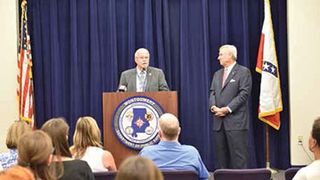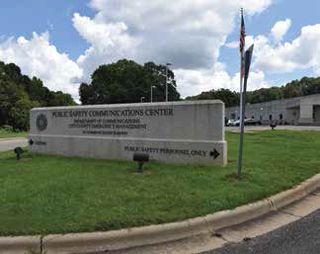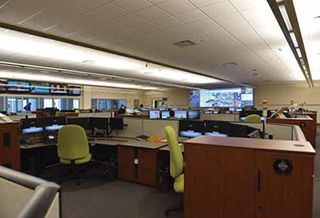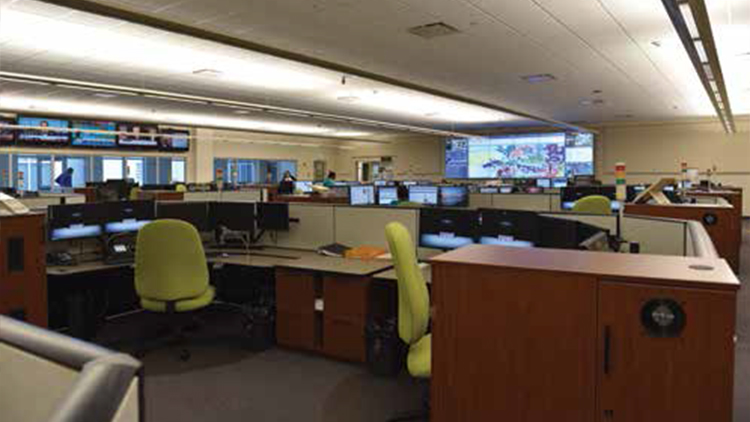Montgomery, Alabama’s 911 Call Center connects the community of Montgomery to its police, fire, and EMS teams to resolve critical situations. Dispatchers at the facility answer emergency calls, assess incidents, and communicate critical dispatch information to emergency responders. Overseen by the Montgomery Department of Emergency Communications, the 911 Call Center employs 50 staff members and handles over 300,000 emergency calls per year.
THE CHALLENGE


The Montgomery 911 Call Center’s new informational tools and visualization system have transformed the workflow of its dispatchers. In 2014, Emergency Communications Director Larry Fisher noticed some workflow obstacles affecting the 911 Call Center’s dispatchers. Seated at isolated workstations with only desktop monitors to display their information, the dispatchers had no visibility into the calls being processed by other team members. This siloed workflow made it difficult for them to identify connections between calls or determine if a call pertained to an already-reported incident. The lack of a real-time common operating picture limited situational awareness.
The dispatchers were struggling with another workflow challenge as well: After assigning an incident to a field unit, the dispatchers had limited tools for tracking the incident’s ongoing developments, which prevented them from communicating valuable updates to the emergency responders.
To provide his team with more effective tools, Larry Fisher began working with city leadership and the local Alabama 911 Board to plan a major update for the Montgomery 911 Call Center. The group decided to implement several new software tools to provide dispatchers with accurate, real-time information and improve communication with emergency responders. They also planned to install a video wall system, which would play the critical role of uniting and displaying the data flowing in from these new informational tools.
After evaluating several vendors, the City of Montgomery selected CineMassive to provide the 911 Call Center’s new video wall system. “CineMassive was the complete package,” explained Larry Fisher. “They had the video wall itself, they had the controlling system and software, and they had the ability to manipulate the data feeds on the screens.”
THE SOLUTION
Completed in August 2016, the upgrades implemented in Montgomery’s 911 Call Center have visibly transformed both the facility itself and the workflow of its employees.
Mounted at the front of the room, a bright, 6x3 CineView LCD video wall displays an arrangement of live camera feeds and real-time digital tools, including a P25 radio system, a Computer-Aided Dispatch (CAD) call mapping program, a Next Generation 9-1-1 system, and ShotSpotter, a real-time gunfire detection solution that maps the location of shots fired in the city. A CineMassive Alpha video wall controller allows all of these applications to be displayed on the video wall simultaneously and arranged in any layout desired.
The team’s shift commander and supervisors sit directly in front of the video wall, controlling the content displayed on the screens. Seated opposite them at 28 new, ergonomic workstations facing the displays, the facility’s dispatchers scan the content on the video wall as they receive and respond to calls. The CineView video wall’s high-resolution displays and ultra-narrow bezels ensure that all of the employees in the large room have a clear view of the content.
PROVIDING DISPATCHERS WITH REAL-TIME SITUATIONAL AWARENESS

“The video wall provides everyone with a visual as to what’s going on throughout the city,” said Larry Fisher. As dispatchers answer emergency calls, they now use the video wall to monitor their phone system, radio, and the CAD mapping platform, which shows the locations of emergency callers and response units on a live map of the city. Equipped with this real-time common operating picture, the dispatchers are now able to visualize patterns in incoming calls and quickly identify connections between incidents.
“The video wall provides everyone with a visual as to what’s going on throughout the city,” explained Larry Fisher. “If they have a call, and they see that the call pops up in the exact same area as the surrounding calls, then they can tell that it could be associated. When a call pops up in a different area, then they know it’s something different.”
CONNECTING DISPATCHERS AND RESPONSE UNITS WITH CRITICAL INFORMATION
When a call requires a response unit, dispatchers can now leverage the data displayed on the video wall to provide critical details to first responders. After connecting with a response unit, dispatchers use the video wall and the software tools at their workstations to gather further information and monitor developments in the situation. Maintaining contact with responders as they approach the scene, the dispatchers provide them with real-time updates and key information—like the locations of windows and exits in a building with an armed suspect.
“It helps get our officers more information as they’re responding to the calls, getting them prepared for what they’re going to experience when they get there,” said Maj. A.S. Tatum of the Montgomery Police Department, explaining how the new workflow helps responding police units. “Any additional information they can get will help them, once they get on the scene, to better save lives and protect themselves also.”
SIMPLE, USER-FRIENDLY CONTROL
When a situation demands a particular set of tools and information, supervisors use CineMassive Touch Control software to quickly adjust the content on the video wall. Loaded on a simple touch panel, the software offers a selection of custom layouts that have been prearranged for various situations.
“They change the content frequently,” explained Larry Fisher. “If news media has a story and they think it’s of interest to everybody, they’ll pull up a layout focused around the TV. If there’s something happening on a camera somewhere in the city, they’ll pull up that camera.”
THE BENEFITS
The Montgomery 911 Call Center’s new informational tools and CineMassive visualization system have transformed the workflow of its dispatchers. By enhancing the team’s situational awareness and improving communication with first responders, city officials believe the technology will help save more lives and improve outcomes for citizens. “People are at the heart and soul of everything we do here,” asserts Mayor Todd Strange, “but you’ve got to have good technology too.” Looking to the future, the city hopes to extend the 911 Call Center’s CineMassive visualization system into two additional environments —the Emergency Management Agency (EMA) and the Director’s Crisis Center (DCC). This integration would enable real-time information-sharing between the three groups, aiding in the coordination of emergency response efforts.
Info
CINEMASSIVE
CineMassive.com
MONTGOMERY 911 CALL CENTER
www.montgomeryal.gov/city-government/city-departments/emergency-communications










